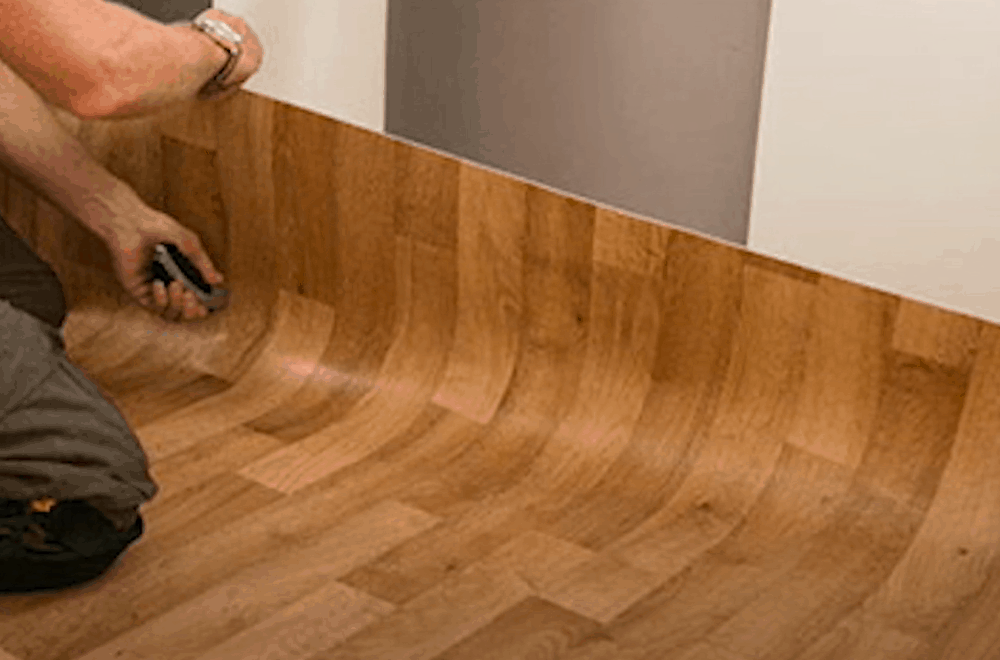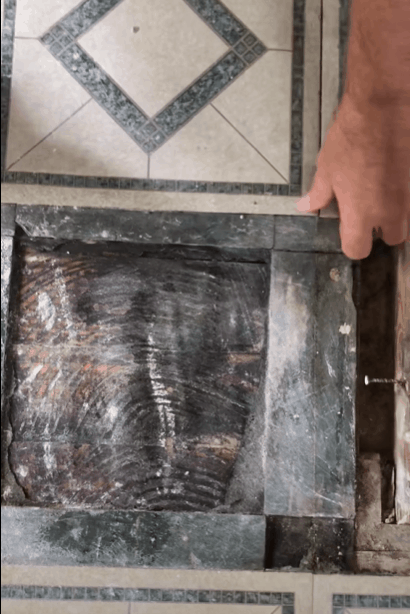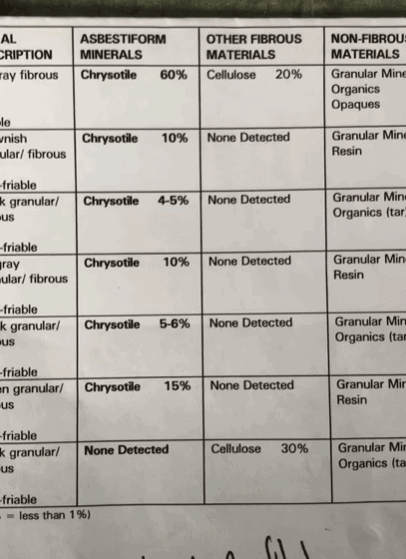How can you know that your floor is asbestos? Well, this is a question that many people keep asking every time. Here, we’ll talk about asbestos sheets floors, how to identify and remove them.
This question is never easy to answer. It’s because asbestos sheets are tiny and thin to know them. You might even think that it’s a new style of floor in the market.
Also, it’s common in making houses, but never safe. If you are lucky, you’ll know it soon enough and avoid it. But what if you don’t know?
So, what are these asbestos sheet floors? Read on to know what they mean.
Table of Contents
What is Asbestos Sheet Flooring?
In the vinyl plank and tiles floors industry, many firms used asbestos in making their things. Up until the 1980s, it was helpful as a fireproof material for floors and pipes. So, that’s why the sheet floors had the label of the asbestos sheet.
Asbestos sheet floors come in brown, white, and blue colors.
So, as for the vinyl sheet floors, asbestos comes in as a backing and can serious health issues. As for the vinyl tiles, asbestos comes as glue while placing them on your surface.
Even now, some companies still use this chemical in making floors.
But why choose asbestos? Well, it because it’s a cheap material and easy to use. It shows why sheet floors were not costly back in the day.
After the late 1980s, people chose not to use them in making floors. It’s because asbestos sheet floors brought illnesses like lung cancer to people. Both people at home and the makers got these problems.
Today, it’s rare to get new lines of sheet floors that have asbestos. But you can get exposure from old surfaces and houses.
How can you Identify Asbestos Sheet Flooring?
If you use an old floor sheet or live in an old building, how can you know that the floor is asbestos? Remember, not every old floor has asbestos in them. Some lines like the Excelon Supreme were free of these dangers.
But can you smell asbestos? No, but most harmful chemicals have a strange smell to help you know them.
Look at this point. If your gas leaks in the kitchen, it will be easy to know. You won’t see it, but at least you’ll sense that something isn’t right.
But this will never apply to asbestos. Sometimes you can’t see it, but you’ll never know how it smells.
There are many ways to help you know that your sheet flooring has asbestos. Let’s take a look at them.
1. Use a designated substance survey (DSS)
Well, with this tech, you’ll know which specific parts of your sheet floors have asbestos. But what is a DSS? It’s a modern way of checking for poisonous things in your house.
So, what’s the primary use of a DSS? It helps to know if there’s any threat to the health of people living in a house. Also, during the construction of buildings, DSS helps in keeping the workers safe and healthy.
It’s similar to using an asbestos survey. But, there’s a slight difference. With DSS, you can use it in your home and commercial places. Also, the asbestos survey, it’s only for commercial areas.
Today, you can ask for a DSS inspection from the authorities. It will help identify a list of many harmful chemicals on your sheet floors. In the checking list, expect to find asbestos.
With the survey and DSS, the inspectors will give you a lab report. So, you’ll know the following info:
- Where to get the asbestos
- The type
- Condition of the sheet floors
- Amount of asbestos
Also, the report will advise you on what to do. Expect that removing the sheet floors will be among the steps. In some cases, you can go for compensation from the seller of the sheet floors.
But if there’s no asbestos, there will be no further steps for you.
2. Look for the specific design
Back before the late 1980s, many sheets and tiles had the size of 9 by 9 inches. It was common for both vinyl sheets and tiles. Also, these sheet floors had adhesives to help in placing the sheets.
Remember, firms made adhesives using asbestos. It was after the late 1980s that companies began creating floors that were free from these chemicals.
Also, firms began making vinyl sheets and tiles in many sizes and colors. But they kept on making the planks without asbestos, up to today.
Getting the sheet floors of the nine by 9 inches size isn’t easy. So, expect to find them in old houses.
The sheets are very thick. Also, these layers have many shapes, cutouts, and patterns. But be careful because many vinyl sheets have many forms.
3. Use the flooring identification index
These days it’s easy to know if your floor has asbestos elements. So, using the asbestos flooring classification guide, you’ll know if your brand is on the list of those having asbestos.
In the guide, it tells you that asbestos isn’t illegal in homes and any building. But if it’s in a bad state and the chemical gets into the air, it becomes terrible.
So, the list is in parts of years. Every sheet floor is with years of when their firm made it. Also, every sheet floor comes with a picture.
With the photo and years guide, you’ll know which sheet floors have these chemicals.
4. Look at Packaging
The package or box of the sheet floors can also help. Using the historical info like the dates of manufacture, you can know if the sheets have asbestos. Also, the dates of placing them in your home will help.
By knowing the age of the sheet floors, you’ll look at the number of layers and materials of the sheets. So, be sure that most sheet floors of before the late1980s had asbestos. But those that came after 1986 are safe and free from asbestos.
Besides the age, look for the line’s name on the packaging.
But how can you know the brand name of the sheet floor has asbestos? You refer to the flooring index list of asbestos. It has the name of all brands, pics, and when the company made them.
Names like Asphalt and Vinyl asbestos were common before the 1980s. Remember, you can find them in many old houses.
Which are the ways to manage asbestos sheet flooring?
After you’ve known that your floor sheets have asbestos, what next? Well, you shouldn’t panic.
These chemicals won’t cause any problems to you if you don’t damage your floor. It’s from this point that the chemicals can harm you. So, if you see any cracks on the floors or tiles, you are at a high risk of inhaling the chemicals.
But what can you do? Take a look at how you can manage the asbestos sheet floors.
Maintain the Floors
As companies make the vinyl floors, they ensure that the material doesn’t expose you to health dangers. So, every firm will advise you to place the sheet floors well and maintain them.
It will keep your house with a good look. Also, you’ll be safe from any exposure to chemicals. You’ll only need to make sure that your floors are in a good state.
So, you should always check for any cracks on the floors. It’s through the damages that you’ll inhale the asbestos.
Do you see any crack? Repair and fill it. You’ll prevent any problems.
Also, asbestos can easily break. So, don’t place heavy furniture or material on these floors.
Remove the Floors
Are you sure that your floor has asbestos? Then, removing them is also a good choice. You only have to do it safely.
Well, before going for this option, be aware of the problems and risks. The activity will be costly, takes more time, and could harm your health.
Also, removing them can destroy the beauty of your home. Depending on where you live, disposing of the asbestos sheet floor wastes can be wrong.
So, if you aren’t ready to handle these problems, maintain your floors or call a pro to do it for you. If you choose to remove the asbestos sheet floors, please do it with care. Also, follow these steps.
- In some places, you’ll need a permit to remove them.
- Then, choose the best way to remove the asbestos floor.
- Get the protective wear and tools for the work.
- Prepare the house by cleaning and sweeping
- Build an area to place the asbestos
- Start by removing the floors using the peeling method. Remember to do it in sections.
- Wet and remove all wastes. Pour a mixture of water and detergent on them.
- Decontaminate the house. Don’t sweep the remains.
But is removal the best option? If you want to keep yourself safer, install another choice of vinyl sheet plank on the asbestos sheets. Also, it will be cheaper for you.
Conclusion
Asbestos sheet floors aren’t the wrong choice. The problems come when you destroy them. You’ll be exposing yourself to its dangers.
Most sheet flooring that came in before 1986 has asbestos in them. But today, it’s hard to find modern sheet floors that have asbestos.
You can maintain, remove them, or add a new floor with no asbestos.
So, are there any questions or more insights about the asbestos sheet flooring identification? Feel free to share them with us.



I have to lay a new vinyl plank floor over existing vinyl however the vinyl has somewhat deteriorate and seams to be breaking apart.
Before i start should get a asbestos check done.
The building is very old.
Kind regards,
Graeme.